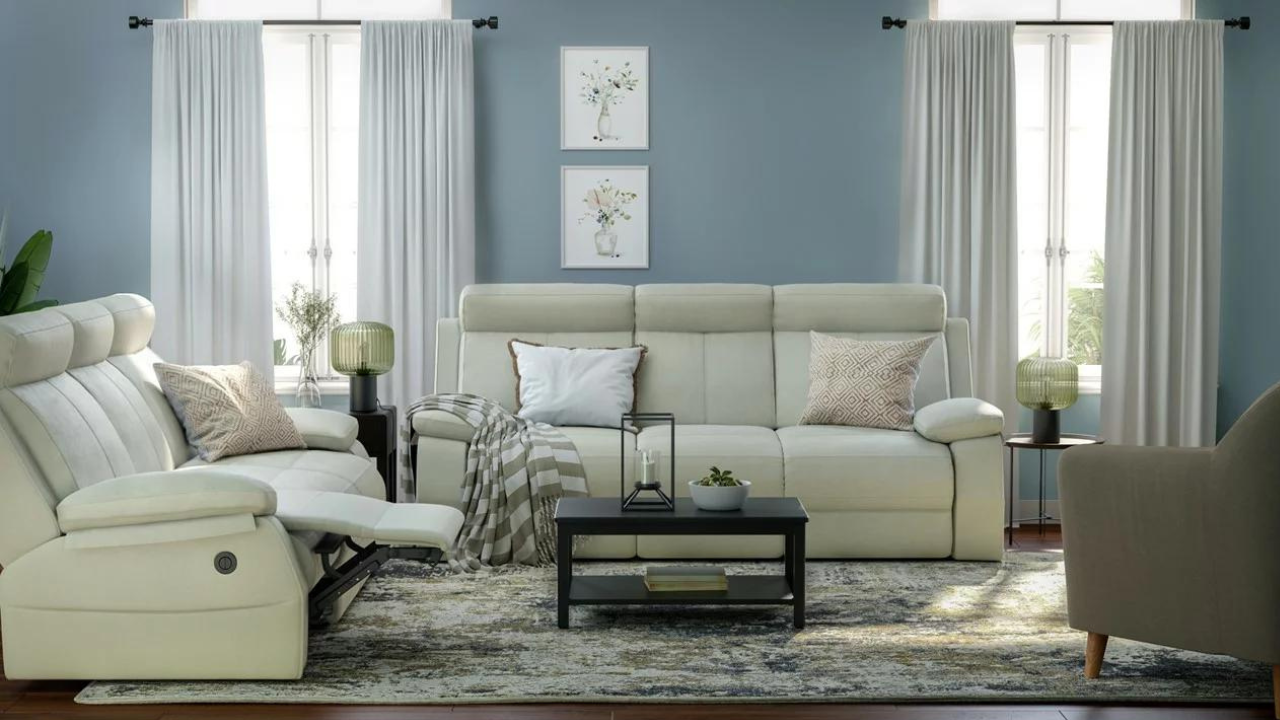The living room is often where we relax, entertain guests, and spend quality time with family. How you arrange your living room furniture can significantly impact its comfort and functionality. Whether you have a small or spacious living room, here are 10 living room furniture layout ideas to help you create an inviting atmosphere. Each layout reveals its unique charm, inviting you to create a living room that suits your lifestyle and brings ultimate comfort to your home’s design.
- The Classic Arrangement
“The Classic Arrangement” is well-suited for small and large living spaces, making it a popular choice among homeowners. This layout emphasises face-to-face interaction and fosters a sense of togetherness, making it perfect for gatherings and get-togethers.
Key Elements:
- Sofa and Loveseat:. These two pieces of seating furniture are typically placed opposite each other. The sofa is usually more oversized and can accommodate more people, while the loveseat offers a cosy spot for couples or individuals.
- Coffee Table: Positioned in the centre of the seating arrangement, the coffee table serves as a focal point and a practical surface. It’s where you can place drinks, snacks, or decorative items.
- Two Chairs: The coffee table and two chairs complete the seating arrangement. These chairs can be armchairs, club chairs, or any style that suits your taste and decor. They provide additional seating options and create a balanced look in the room.
Decorative Touches:
- Enhance comfort and style by adding decorative cushions and throws to the sofa and chairs. Choose fabrics and patterns that complement your overall decor.
- Consider placing an area rug beneath the furniture to define the seating area and add a cosy touch. The rug should be large enough to encompass the entire seating arrangement.
- Decorate the coffee table with a stylish centrepiece, such as a vase of flowers, a decorative bowl, or a stack of books. Personalise the space with art, photographs, or decorative wall items.
- Open Concept Living
This is a strategic furniture layout designed to maximise the functionality and aesthetics of open-concept homes, in homes with open floor plans, where the living room, dining area, and kitchen flow seamlessly into one another, it’s essential to create distinct zones without sacrificing the feeling of openness.
Key Elements:
- Sectional Sofa: The sectional sofa is the cornerstone of this layout. It’s typically a large, L-shaped or U-shaped sofa with ample seating. This type of sofa works well to separate the living area from adjacent spaces visually.
- Area Rug: Placing a large area rug beneath the sectional sofa serves multiple purposes. It defines the boundaries of the living area, adds warmth and texture to the space, and provides a comfortable surface for feet. The rug should be large enough to accommodate the entire seating arrangement.
- Furniture Orientation: Arrange the sectional sofa so that it faces the focal point of the room, which could be a television, fireplace, or a stunning view. This ensures that seating is oriented toward a central feature.
Decorative Touches:
- Choose a colour scheme for your sectional sofa, area rug, and other furnishings that complement the overall design of your open-concept space. Coordinating colours helps create a cohesive look.
- Add throw pillows and blankets to introduce patterns and textures while enhancing comfort and style.
- Strategically incorporate floor lamps, table lamps, or pendant lights to illuminate different zones within the open space.
- The Corner Sofa
This layout is a smart, space-efficient furniture arrangement ideal for smaller living room corners. It maximises seating while making efficient use of available space.
Key Elements:
- L-Shaped Sofa: The L-shaped sofa is the focal point of this arrangement. It’s characterised by its distinctive L-shaped design, with one section typically longer than the other. This shape allows for ample seating while fitting snugly into a corner.
- Ottoman: The ottoman is a versatile piece of furniture that serves multiple purposes in this layout. It can function as a coffee table when you place a tray on top, as a relaxation footrest or as additional seating.
- Flexibility: One of the advantages of this layout is its flexibility. You can easily move the ottoman to create more open space or bring it closer to the sofa for a chaise lounge effect. It’s a versatile addition to the room.
Decorative Touches:
- Place a decorative tray on top of the ottoman to create a stable surface for setting down drinks and snacks. This also adds an opportunity to display decorative items.
- Artwork and Wall Decor: Decorate the walls around the sofa with artwork, mirrors, or wall shelves. Create a gallery wall with framed art or display a large statement piece above the sofa to draw the eye.
- Incorporate indoor plants or potted succulents to bring a touch of nature into your living space. Plants not only add a refreshing element but also enhance air quality.
- Choose curtains or drapes that complement your colour scheme and style. Hanging curtains on windows near the sofa can add depth and visual interest to the space.
- Minimalist Chic
This arrangement prioritises simplicity and functionality, making it perfect for those who appreciate a clutter-free and uncluttered living space.
Key Elements:
- Low Profile Furniture: This typically includes low-slung sofas, minimalist coffee tables, and modest chairs. These pieces are characterised by their clean lines and minimalistic design.
- Wall-Mounted Shelves: Wall-mounted shelves are essential to this layout. They serve as functional storage and a means to display decorative items like books, artwork, and collectables.
- Declutter: Embrace minimalism by decluttering and keeping only essential and aesthetically pleasing items on display. Consider using storage solutions within your furniture to keep everyday items out of sight.
Decorative Touches:
- Stick to a neutral colour palette with shades of white, grey, beige, or soft pastels to maintain a clean and serene atmosphere. You can add pops of colour through small decorative accents or artwork.
- Select carefully curated decorative items to display on the wall-mounted shelves. These could include art pieces, plants, or a collection of your favourite books.
- Incorporate minimalist lighting fixtures, such as pendant lights or wall sconces, to provide ambient and task lighting without detracting from the clean aesthetic.
- Symmetrical Balance
The symmetrical layout is a classic and timeless arrangement that prioritises balance and harmony in your living room. It’s all about creating a visually appealing and inviting space that exudes a sense of order and symmetry.
Key Elements:
- Matching Sofas: The foundation of this layout consists of two identical sofas. These sofas are typically placed facing each other, creating a symmetrical seating arrangement. The matching sofas serve as the primary seating element.
- Coffee Table: The coffee table is positioned as a central focal point in the centre of the seating area. It provides a convenient surface for placing drinks, snacks, and decorative items. The coffee table can vary in style, from classic to contemporary, depending on your taste.
- Symmetrical Decor: Add matching decor elements on each side of the seating area to achieve symmetry. This can include identical table lamps, artwork, plants, or other decorative items. The goal is to create a mirror-image effect.
Decorative Touches:
- Hang identical or similarly sized and framed artworks on opposite walls or above matching pieces of furniture. Ensure that the spacing and height are consistent for a balanced look.
- Create a mirror image effect by placing the same decorative items on both sides of a room. This can include pairs of lamps, vases, or sculptures on side tables.
- Install wall-mounted shelves in a symmetrical pattern, either side by side or in vertical columns. Display matching decor items, books, or collectables on these shelves.
- Install matching wall sconces, pendant lights, or table lamps on both sides of a room. This provides balanced illumination and adds a decorative touch.
- TV-Centric comfort
This popular arrangement is for creating a dedicated entertainment zone within your living room. This setup is designed to provide comfortable seating for watching TV, organising electronics, and enhancing the overall viewing experience.
Key Elements:
- Sectional Sofa: The sectional sofa is the centrepiece of this layout. It’s typically positioned to face the television, creating an inviting seating arrangement. Sectionals come in various configurations, including L-shaped, U-shaped, and curved, to suit your space and preferences.
- TV Console or Entertainment Center: To house your television and related equipment like cable boxes, gaming consoles, and sound systems, you’ll need a TV console or entertainment centre. These pieces of furniture are designed with storage in mind, keeping your electronics organised and neatly concealed.
- Comfortable Seating: Ensure that every seat on the sectional offers a comfortable view of the TV screen. Depending on your room’s layout, this may involve angling or positioning the sectional accordingly.
Decorative Touches:
- Install ambient and task lighting around the TV area to create a cosy atmosphere. Wall sconces or floor lamps can add a decorative touch while enhancing the viewing experience.
- Use cable management solutions to keep wires and cords organised and out of sight. This helps maintain a clean and clutter-free appearance.
- Enhance the visual appeal of the entertainment zone with decorative items like artwork, plants, or decorative shelves. Just be mindful not to obstruct the TV screen or distract from the area’s primary purpose.
- Cosy Corner Nook
This layout is about creating a cosy and inviting nook in your living room to unwind, read, or simply relax. It’s designed to make the most of an empty corner, turning it into a secluded and comfortable relaxing spot.
Key Elements:
- Comfortable Seating: The cornerstone of any cosy nook is comfortable seating. Choose a plush armchair, chaise lounge, or even a loveseat that you can sink into for hours of relaxation.
- Soft Furnishings: Layer your seating with soft and inviting cushions, throw pillows, and a warm, snuggly blanket. These elements add not only comfort but also a sense of cosiness.
- Floor Pillows: Floor pillows are large, comfortable cushions placed on the floor around the corner sofa. They provide additional seating and enhance the relaxed, bohemian vibe of the space.
Decorative Touches:
- Opt for warm and soothing colours in your nook’s decor. Earthy tones like soft browns, warm greys, and muted yellows can enhance the ambience.
- Customise the space with personal touches, such as a small side table for books and beverages, a reading lamp, or a decorative rug to define the area and add texture.
- Consider adding artwork or decor to the adjacent walls to make the nook more visually inviting. This can be a gallery of framed art, a tapestry, or decorative shelving.
-
Floating Furniture
This setup moves furniture away from the walls, creating a sense of spaciousness while allowing for various seating configurations and a dynamic atmosphere.
Key Elements:
- Floating Sofas: This layout’s primary seating elements are sofas positioned away from the walls. Depending on your space and seating needs, these sofas can be of various styles, such as sectional, loveseats, or regular sofas.
- Furniture Placement: Instead of placing your sofas against the walls, arrange them in the centre of the room, facing each other or at right angles. This creates a more inviting and intimate seating arrangement.
- 3. Versatility: One of the advantages of this layout is its versatility. You can easily reconfigure the seating arrangement or add seating for different occasions or activities.
Decorative Touches:
- Incorporate floor lamps, pendant lights, or table lamps to provide focused lighting for each seating area. This helps create cosy and well-lit zones within the open space.
- Incorporate decorative elements on the floor, such as large floor vases, decorative rugs, or unique floor sculptures.
- Introduce decorative room dividers or screens to create distinct zones within the open layout. These can serve both functional and decorative purposes.
-
Multifunctional Furniture
This arrangement combines a multifunctional sleeper sofa with versatile storage ottomans to maximise your space while maintaining style and comfort.
Key Elements:
- Sleeper Sofa: The sleeper sofa is a versatile piece of furniture that can serve as a comfortable seating area during the day and transform into a bed when needed for guests. It typically features a fold-out or pull-out mechanism for easy conversion.
- Storage Ottomans: Storage Ottomans are multi-purpose furniture that offers seating and hidden storage. They often have a hinged top that opens to reveal ample space for stashing away items like blankets, pillows, or magazines.
- Convertible Convenience: Consider the direction it opens when arranging the sleeper sofa. Ensure there’s enough space to extend without obstructing other furniture or pathways.
Decorative Touches:
- Utilise decorative storage bins and baskets to keep clutter at bay. These can be placed on open shelves or tucked away beneath multifunctional furniture.
- Consider custom-built storage solutions like wall-mounted cabinets or built-in shelving units. These can be tailored to fit your space and decor preferences.
- The Reading Nook
This arrangement encourages relaxation, provides a dedicated spot for reading, and keeps your favourite books, magazines, and research work within easy reach.
Key Elements:
- Armchair: The armchair is the central piece of furniture in this layout. It should be chosen for its comfort and style, ensuring a welcoming place to sit and enjoy a good book.
- Side Table: The side table complements the armchair and is a convenient surface for placing books, a reading lamp, a cup of tea, or other reading essentials.
- Bookshelves: Whether wall-mounted or freestanding, bookshelves store and display your favourite reads. They keep your book collection organised and within easy access to your reading nook.
Decorative Touches:
- Choose a reading lamp with adjustable lighting to create the perfect reading ambience. It should be positioned on the side table for easy access.
- Add floor pouffes or cushions to create additional seating or a place to prop up your feet while reading.
- Set the mood with scented candles or essential oil diffusers. Choose calming scents like lavender or eucalyptus to enhance your reading experience.
We’ve discovered how the arrangement of sofas, chairs, tables, and decor can influence our cherished living spaces’ aesthetics, functionality, and atmosphere. Experiment with these layouts and personalise them to suit your taste and lifestyle. Remember that comfort and functionality should always be at the forefront of your design choices.
As we conclude this journey, we’d like to introduce you to a brand that understands the essence of crafting living spaces that are beautiful, exceptionally comfortable, and functional. With metercube, you can explore various possibilities, from classic arrangements that exude timeless elegance to modern designs that embrace innovation and creativity.








